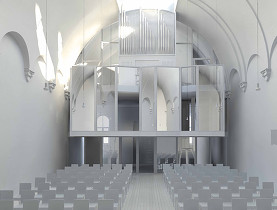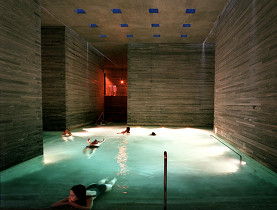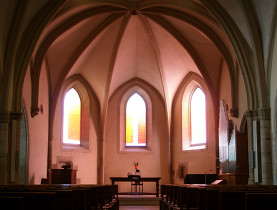London’s Swiss church re-opens to great applause

London's Swiss community was out in force this weekend as hundreds gathered to celebrate the re-opening of the capital's Swiss Church.
Braving November downpours and negotiating their way through crowds of Christmas shoppers, church-goers, dignitaries, donors, and well-wishers came together in a quiet side street a few hundred metres from the bustle of Covent Garden to admire the refurbished interior of the Grade II listed building.
Basel architects Christ & Gantenbein, who have achieved international acclaim in recent years and are renowned for their fresh approach to architectural design, were awarded the £2.2 million (SFr3.7 million) refurbishment project, which was funded by private donations and a massive fundraising drive by the extensive Swiss community in London.
“Our main task was to successfully blend the old structure with more contemporary elements,” architect Emanuel Christ told swissinfo.ch.
“We achieved this by creating a transparent structure using glass and mirrored panels to highlight the features of the 19th-century architecture, while making it feel very modern and spacious with a freestanding structure right above the entrance that offers additional office and exhibition space.”
The original church was founded by French-speaking Swiss Protestants in 1762 and has been the spiritual home of Swiss ex-pats in London ever since. Churchgoers regularly come together for services in English, French and German, and for other spiritual events.
The current building, built in 1855, required complete renovation and transformation as well as spatial changes to adapt it to current needs, and to give it a better space to expand and develop its cultural programme.
The way forward
The church has always been seen as an important meeting place for the Swiss community in London and Ursula Jost, president of the Consistoire of the Swiss Church, is looking forward to the newly transformed building becoming even more visible and a focal point for all British-based Swiss and friends of Switzerland.
“An interesting programme of cultural and social activities is planned for the coming months, and popular events with a Swiss touch are likely to continue, such as our Swiss film series and raclette lunches after Sunday services,” she said.
Young up-and-coming musicians and artists studying in nearby colleges will also be given the opportunity to showcase their work there.
“This is not only an attractive and flexible space, but we have first-class acoustics” Jost said. “So we are working together with Trinity College of Music and the Central Saint Martins College of Design and Art as we want to encourage students to use the venue as a platform for concerts, exhibitions and the visual arts.”
Fresh artistic talents from Switzerland will also be invited to perform and display their work.
Switzerland’s Ambassador to Britain, Alexis Lautenberg, fully supports plans to develop the venue’s cultural and social activities.
“This is a huge construction that can be used for worship, but what do you do the rest of the time?” he told swissinfo.ch.
“I think it’s an extraordinary privilege, particularly in this part of town, to have the opportunity to have this fantastic space to promote the arts. I’m sure it’s going to be highly successful and we at the embassy are looking forward to working with [the Swiss Church’s arts committee].”
Adapting to change
However, during the weekend of festivities some members of the congregation were already voicing their concerns about the focus being too much on the arts.
“I do hope it will remain a church and not become a multi-functional gathering place for cultural events,” said one parishioner. “But that will be up to those that use the building to decide.”
Reverend Nathalie Duermueller is well aware of the diverse views in her congregation about the way forward for the church.
She stressed that people shouldn’t lose sight that the building is first and foremost a church, but she accepts that nowadays not everybody wants to be involved with traditional forms of worship.
“We want to serve people and do something for the broader audience and hopefully this will also give an input to our church life, so both sides should benefit,” she said.
However, Duermueller understands and accepts some members of her congregation may take longer to embrace the whole process of change taking place.
“I recently interviewed the eldest members of the church for our magazine and for them it’s a challenging process,” she said.
“A large part of their life history is connected to this building, so they are not altogether positive about the changes. But I’m sure once they see what has been done here, they will be happy and will adapt to it.”
Andrew Littlejohn in London, swissinfo.ch
The Eglise Helvétique in London was established in 1762 by a group of expatriate “Swiss”, most of whom were not officially Swiss as they had mainly come from Geneva and Neuchâtel, which were not yet part of the Swiss Confederation.
Under the inspiration of Justin Vulliamy, the first Consistoire or Group of Anciens as they were then known inaugurated the church. They rented a large room in Castle Street, Leicester Fields, and appointed Antoine Bugnion from Lausanne as their first pastor. As well as being a spiritual home for the expatriate Swiss, the church also became a centre of help for indigent Swiss in London.
In 1775, after appeals for funds and some financial aid from Geneva and Bern, the first purpose-built “Helvetic Chapel” was built near Moor Street in Soho. This remained the focal point for the Swiss in London for 80 years. The congregation was mainly French-speaking during that time.
The church also played an important role in the legal protection of the Swiss abroad in the early part of that period. There was no consular representation until 1817, so they had to rely on the pastor to be signatory for any important documentation regarding their status, including “pass-ports”.
1855 saw the inauguration of the current building in Endell Street, after much planning and fundraising in England and Switzerland.
In 1973 the Swiss Church was designated a Grade II, a building that English Heritage deems worthy of preserving for posterity.

In compliance with the JTI standards
More: SWI swissinfo.ch certified by the Journalism Trust Initiative




You can find an overview of ongoing debates with our journalists here. Please join us!
If you want to start a conversation about a topic raised in this article or want to report factual errors, email us at english@swissinfo.ch.